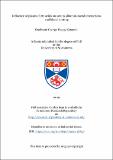Files in this item
Influence of plasma fatty acids on serum albumin-metal interactions and blood clotting
Item metadata
| dc.contributor.advisor | Stewart, Alan J. | |
| dc.contributor.author | Katundu, Kondwani George Happy | |
| dc.coverage.spatial | 219, [15] p. | en_US |
| dc.date.accessioned | 2019-11-05T12:01:10Z | |
| dc.date.available | 2019-11-05T12:01:10Z | |
| dc.date.issued | 2019-12-03 | |
| dc.identifier.uri | https://hdl.handle.net/10023/18847 | |
| dc.description.abstract | Non-communicable diseases (NCDs) are a cause of high mortality and morbidity globally. HIV infection has complicated the burden of NCDs further by increasing its prevalence, mostly in lowand middle-income countries. NCDs and HIV are associated with higher plasma free fatty acids (FFA) in plasma and are risk factors for thromboembolic events. Human serum albumin (HSA) is a carrier of many metal ions and is also the primary transporter of FFA in plasma. Higher concentrations of FFA in plasma and their binding to the fatty acid binding site FA2, may elicit conformational changes that may perturb metal binding at site A. The binding affinity of albumin to Co²⁺ and Zn²⁺ can be compromised in pathological conditions associated with higher FFA concentrations and can influence clinical diagnostic tests such as the albumin cobaltbinding (ACB) assay. Zn²⁺ is a key regulator of haemostasis, and the concentration of labile Zn²⁺ in plasma is tightly regulated through binding to HSA. Abnormally high FFA concentrations can thus allosterically disrupt the binding of Zn²⁺ to HSA and potentiate abnormal platelet aggregation. This thesis aimed to assess the influence of elevated FFA concentrations on the interaction between albumin and metal ions in the circulation, and how abnormal pathophysiological processes such as thromboembolic events may be precipitated in pathological conditions especially in NCDs and HIV infection due to the higher FFA levels. The results of this study, using the albumin cobalt binding (ACB) assay, showed that long chain fatty acids perturbed the binding of Co²⁺ at the multimetal binding site A, which is also the primary binding site for Zn²⁺, in a concentration-dependent manner. These results were also supported by isothermal titration calorimetry. Platelet aggregation experimental results revealed that Zn²⁺, in the absence of HSA, potentiated platelet aggregation by positively influencing the maximum and rate of aggregation responses. Higher (supraphysiological) concentrations of added myristate, but not octanoate, positively affected the maximum platelet aggregation responses, plausibly via allosteric Zn²⁺ switch from albumin. The in-silico analysis of albumin crystal structures examined in this project, exposed the disruption of the primary Zn²⁺ -binding site on albumin by long chain fatty acids, due to changes in the distances between the specific amino acid residues forming the site. Lastly, a clinical study was conducted to investigate the FFA concentrations, albumin levels and coagulability in HIV – infected individuals compared to controls. The results indicated that participants with HIV infection and recently commenced on (antiretroviral therapy) ART had subnormal levels of albumin concentration than the controls. Also, the FFA concentrations were significantly higher in HIV – infected participants on ART for more than 6 months than the controls. Nevertheless, the coagulability tests assessed by international normalized ratio (INR) and the turbidity tests of plasma did not show any differences among the groups. These study results contribute to the body of knowledge on how FFA can influence abnormal handling of Zn²⁺ by HSA in circulation, which may precipitate platelet aggregation and increase the risk for thromboembolic events, such as stroke, in populations at risk. Possible and relevant suggestions on how the mishandling of Zn²⁺ by HSA may be mitigated in populations at risk have been discussed. | |
| dc.description.sponsorship | "The University of St Andrews through the global health implementation program, the Commonwealth Scholarship Commission and the College of Medicine, University of Malawi - thank you for the funding support." -- Acknowledgements | en |
| dc.language.iso | en | en_US |
| dc.publisher | University of St Andrews | |
| dc.subject.lcc | QP99.3A4K2 | |
| dc.title | Influence of plasma fatty acids on serum albumin-metal interactions and blood clotting | en_US |
| dc.type | Thesis | en_US |
| dc.contributor.sponsor | University of St Andrews | en_US |
| dc.contributor.sponsor | Global Health Implementation Programme (Gloag Foundation and the Western Union Foundation) | en_US |
| dc.contributor.sponsor | Commonwealth Scholarship Commission in the United Kingdom | en_US |
| dc.contributor.sponsor | University of Malawi. College of Medicine | en_US |
| dc.type.qualificationlevel | Doctoral | en_US |
| dc.type.qualificationname | PhD Doctor of Philosophy | en_US |
| dc.publisher.institution | The University of St Andrews | en_US |
| dc.rights.embargoreason | Embargo period has ended, thesis made available in accordance with University regulations | en |
| dc.identifier.doi | https://doi.org/10.17630/10023-18847 |
This item appears in the following Collection(s)
Items in the St Andrews Research Repository are protected by copyright, with all rights reserved, unless otherwise indicated.

